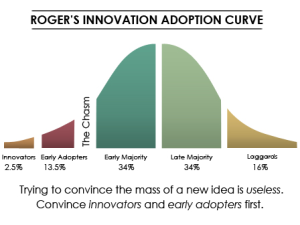 The early phases of a transformation are where most fall by the wayside.
The early phases of a transformation are where most fall by the wayside.
And the failure rate is horrifying – an estimated 80% of improvement initiatives fail to achieve their goals.
The recent history of the NHS is littered with the rusting wreckage of a series of improvement bandwagons. Many who survived the crashes are too scarred and too scared to try again.
Transformation and improvement imply change which implies innovation … new ways of thinking, new ways of behaving, new techniques, new tools, and new ways of working.
And it has been known for over 50 years that innovation spreads in a very characteristic way. This process was described by Everett Rogers in a book called ‘Diffusion of Innovations‘ and is described visually in the diagram above.
The horizontal axis is a measure of individual receptiveness to the specific innovation … and the labels are behaviours: ‘I exhibit early adopter behaviour‘ (i.e. not ‘I am an early adopter’).
What Roger’s discovered through empirical observation was that in all cases the innovation diffuses from left-to-right; from innovation through early adoption to the ‘silent’ majority.
Complete diffusion is not guaranteed though … there are barriers between the phases.
One barrier is between innovation and early adoption.
There are many innovations that we never hear about and very often the same innovation appears in many places and often around the same time.
This innovation-adoption barrier is caused by two things:
1) most are not even aware of the problem … they are blissfully ignorant;
2) news of the innovation is not shared widely enough.
Innovators are sensitive people. They sense there is a problem long before others do. They feel the fear and the excitement of need for innovation. They challenge their own assumptions and they actively seek solutions. They swim against the tide of ignorance, disinterest, skepticism and often toxic cynicism. So when they do discover a way forward they often feel nervous about sharing it. They have learned (the hard way) that the usual reaction is to be dismissed and discounted. Most people do not like to learn about unknown problems and hazards; and they like it even less to learn that there are solutions that they neither recognise nor understand.
But not everyone.
There is a group called the early adopters who, like the innovators, are aware of the problem. They just do not share the innovator’s passion to find a solution … irrespective of the risks … so they wait … their antennae tuned for news that a solution has been found.
Then they act.
And they act in one of two ways:
1) Talkers … re-transmit the news of the problem and the discovery of a generic solution … which is essential in building awareness.
2) Walkers … try the innovative approach themselves and in so doing learn a lot about their specific problem and the new ways to solving it.
And it is the early adopters that do both of these actions that are the most effective and the most valuable to everyone else. Those that talk-the-new-walk and walk-the-new-talk.
And we can identify who they are because they will be able to tell stories of how they have applied the innovation in their world; and the results that they have achieved; and how they achieved them; and what worked well; and what did not; and what they learned; and how they evolved and applied the innovation to meet their specific needs.
They are the leaders, the coaches and the teachers of improvement and transformation.
They See One, Do Some, and Teach Many.
The early adopters are the bridge across the Innovation and Transformation Chasm.
